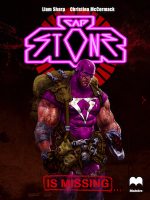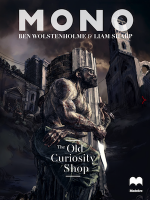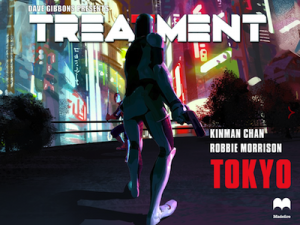Why the Madefire app is the new cutting edge of digital comics
 The new Madefire comic app from Liam Sharp and Ben Wolstenholme isn’t just the cutting edge of digital comics, it’s a completely new format – the motion comic! After speaking to Liam about it back in September last year, this week finally saw the launch of the much anticipated Madefire app and it’s first 3 titles – Captain Stone is Missing, Mono and Treatment Tokyo. All three are prologues or first chapters to the up-coming titles that Madefire are planning to launch and can be viewed on their completely bespoke viewing platform for free.
The new Madefire comic app from Liam Sharp and Ben Wolstenholme isn’t just the cutting edge of digital comics, it’s a completely new format – the motion comic! After speaking to Liam about it back in September last year, this week finally saw the launch of the much anticipated Madefire app and it’s first 3 titles – Captain Stone is Missing, Mono and Treatment Tokyo. All three are prologues or first chapters to the up-coming titles that Madefire are planning to launch and can be viewed on their completely bespoke viewing platform for free.
Make no mistake, this isn’t just a re-skinned version of ComiXology! Using it’s own bespoke navigation system (the Madefire arrow, which sits on the right hand side of the page and serves as page turner and progress bar) you can view pages literally building in front of you thanks to a series of fantastic animated transitions. There are also cinematic zooms and intricately constructed pages which make the titles feel like much more than just a flat page-turner. They even use the iPad’s accelerometer on some of the pages (including each book’s cover) to allow you to move elements around on screen while other pages involve 360 degree panoramas that really bring the books to life, but are they any good? Well here is our break down of the first three Madefire titles.
Captain Stone is Missing by Liam Sharp and Christine McCormack
 Captain Stone is the centrepiece of the app, coming as it does from the brain of Liam Sharp himself. Telling the story of the world’s only superhero who disappears from the scene and people’s reaction to that disappearance, it features a fantastic mix of different art styles for each element of the story. From Watchmen-style text pages to 90s Jim Lee style superhero pages for the introduction to Captain Stone. Then there’s also loose pencil drawings with watercolour washes, Dave McKean style photo montages alongside Sharp’s more recognisable airbrush style work. Each story has a completely different look and feel which helps separate the different elements of the story, but perhaps the most eye-catching is as an awesome Saul Bass style homage in the middle which features flashbacks about the main character Charlie’s early years. Despite all these styles breaking the sections of the story up, it can be a bit confusing at times and perhaps could have benefited from a more focused approach?
Captain Stone is the centrepiece of the app, coming as it does from the brain of Liam Sharp himself. Telling the story of the world’s only superhero who disappears from the scene and people’s reaction to that disappearance, it features a fantastic mix of different art styles for each element of the story. From Watchmen-style text pages to 90s Jim Lee style superhero pages for the introduction to Captain Stone. Then there’s also loose pencil drawings with watercolour washes, Dave McKean style photo montages alongside Sharp’s more recognisable airbrush style work. Each story has a completely different look and feel which helps separate the different elements of the story, but perhaps the most eye-catching is as an awesome Saul Bass style homage in the middle which features flashbacks about the main character Charlie’s early years. Despite all these styles breaking the sections of the story up, it can be a bit confusing at times and perhaps could have benefited from a more focused approach?
The pages look great though and all incorporate super slick animated transitions alongside pages which assemble themselves and more familiar guided view style pages that you would see in ComiXology apps. Unlike it’s big time rival through, music and sound effects help to further create an extra level of ambiance for certain pages, however they’re not on all of them which makes some feel less important than others. For example the scene where Charlie confronts her father has no sound, after a key scene which has lots of sound and so the balance feels slightly odd. Despite these minor drawbacks, Captain Stone is still a real tour de force that looks great and really shows the app off at it’s best albeit at the slight expense of the story.
Mono
 The relative unknown of the three (at least in comics circles), Ben Wolstenholme’s Mono (written in conjunction with Liam Sharp), is a historical book that tells the story of an old man looking back on the adventures of the titular World War II super-soldier, Mono. A bit like Bucky Barnes looking back on a more savage and gruesome version of Captain America, comparing the romanticised versions of his story that appears in the paperbacks in his antique shop with the true life events that inspired them by reading Mono‘s diaries to find out more about his close friend. The book features incredible hand drawn art from Wolstenholme with amazing detail, even when zoomed in. Pictures have a dense textured feel that contrast well with the other titles and the motion graphics have a very cinematic feel with a lot of zooms in and out of panels, and animated actions (such as the main character removing a book from a library shelf). Clever transitions show the passage of time by switching from day to night in the same shot and subtle uses of colour help give the book a really sophisticated feel. All this really works well with the story and actually helps improve the narrative rather than just show off the app’s features. One of the features it uses especially well is the 360 panorama which features a stunning image of a war torn battlefield that with it’s new multi-angle perspective feels much more immersive compared to the trippy dream sequence in Captain Stone and works really well to make the page feel like more than just a traditional comic page. The story itself is just a tantalising glimpse into the world of Mono, and is one that will definitely pique readers’ curiosity to find out more.
The relative unknown of the three (at least in comics circles), Ben Wolstenholme’s Mono (written in conjunction with Liam Sharp), is a historical book that tells the story of an old man looking back on the adventures of the titular World War II super-soldier, Mono. A bit like Bucky Barnes looking back on a more savage and gruesome version of Captain America, comparing the romanticised versions of his story that appears in the paperbacks in his antique shop with the true life events that inspired them by reading Mono‘s diaries to find out more about his close friend. The book features incredible hand drawn art from Wolstenholme with amazing detail, even when zoomed in. Pictures have a dense textured feel that contrast well with the other titles and the motion graphics have a very cinematic feel with a lot of zooms in and out of panels, and animated actions (such as the main character removing a book from a library shelf). Clever transitions show the passage of time by switching from day to night in the same shot and subtle uses of colour help give the book a really sophisticated feel. All this really works well with the story and actually helps improve the narrative rather than just show off the app’s features. One of the features it uses especially well is the 360 panorama which features a stunning image of a war torn battlefield that with it’s new multi-angle perspective feels much more immersive compared to the trippy dream sequence in Captain Stone and works really well to make the page feel like more than just a traditional comic page. The story itself is just a tantalising glimpse into the world of Mono, and is one that will definitely pique readers’ curiosity to find out more.
Treatment Tokyo
 This final offering is perhaps the strongest and best realised of all the Madefire books. Based on characters created by Dave Gibbons, Treatment Tokyo is part of the larger Treatment Universe where criminals are hunted down as part of a brutal reality TV show. With it’s landscape format it instantly stands out from the others – albeit, not as a wholly original idea as we have seen landscape books already in the Marvel Infinite titles. The artwork and direction by Kinman Chan is truly exceptional with it’s stylised mixed media art it’s part manga and part water colour and contrasts nicely with the action packed storyline. With it’s relatively simple plot and high octane action sequences it helps creates the best balance of animation and story telling of all the Madefire titles. Pages don’t just move they assemble on top of each other and animate to create dynamic action, which is where this type of story telling works best and is where digital comics are at their strongest. By not relying on the traditional portrait format or panel grids it feels really special and the way that characters move in and out of frame as pages build in front of you is very clever indeed. The tapping to reading ratio is much lower than on the other titles thanks to it’s clever use of animated sequences but despite all this it still retains the pure readability of a comic. This is one of the very best digital comics out there today and is a real high water mark for those involved.
This final offering is perhaps the strongest and best realised of all the Madefire books. Based on characters created by Dave Gibbons, Treatment Tokyo is part of the larger Treatment Universe where criminals are hunted down as part of a brutal reality TV show. With it’s landscape format it instantly stands out from the others – albeit, not as a wholly original idea as we have seen landscape books already in the Marvel Infinite titles. The artwork and direction by Kinman Chan is truly exceptional with it’s stylised mixed media art it’s part manga and part water colour and contrasts nicely with the action packed storyline. With it’s relatively simple plot and high octane action sequences it helps creates the best balance of animation and story telling of all the Madefire titles. Pages don’t just move they assemble on top of each other and animate to create dynamic action, which is where this type of story telling works best and is where digital comics are at their strongest. By not relying on the traditional portrait format or panel grids it feels really special and the way that characters move in and out of frame as pages build in front of you is very clever indeed. The tapping to reading ratio is much lower than on the other titles thanks to it’s clever use of animated sequences but despite all this it still retains the pure readability of a comic. This is one of the very best digital comics out there today and is a real high water mark for those involved.
Madefire is available for free from the iTunes Store. You can follow Liam on Twitter @liamrsharp, Ben Wolstenholme @movingbrands and Dave Gibbons @davegibbons90



Pipedream Comics Top 10 Digital Comics of 2012 | Pipedream Comics
December 28, 2012 @ 7:55 am
[…] 3. Treatment Tokyo (Madefire) Based on characters created by Watchmen legend Dave Gibbons, Treatment is a delightfully simple premise – criminals are hunted down on tv for entertainment – and it is allowed to develop in a variety of scenarios thanks to its clever creative teams. With stories set all around the world, this Tokyo instalment was the real gem of the series, making the Madefire motion comics elements work in a much more traditional comics format but making the most of incredibly clever use of space and motion on the pages to create an action packed adventure from start to finish. Read our comprehensive round-up of the Madefire launch titles […]